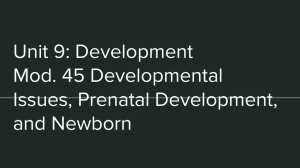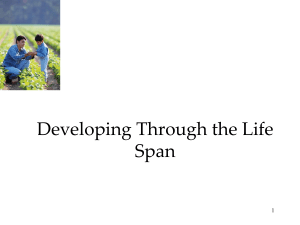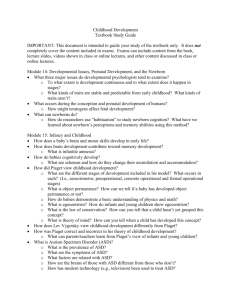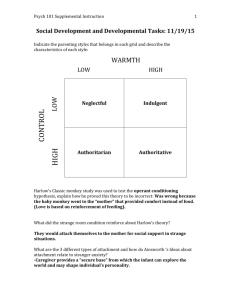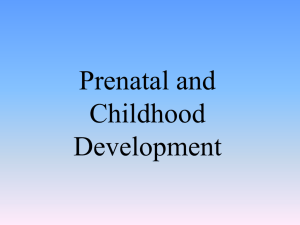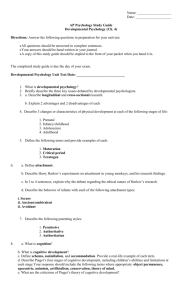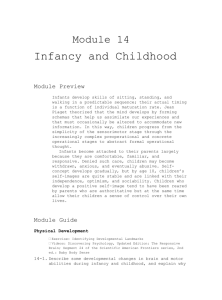EXPLORING PSYCHOLOGY (7th Edition in Modules) David Myers
advertisement
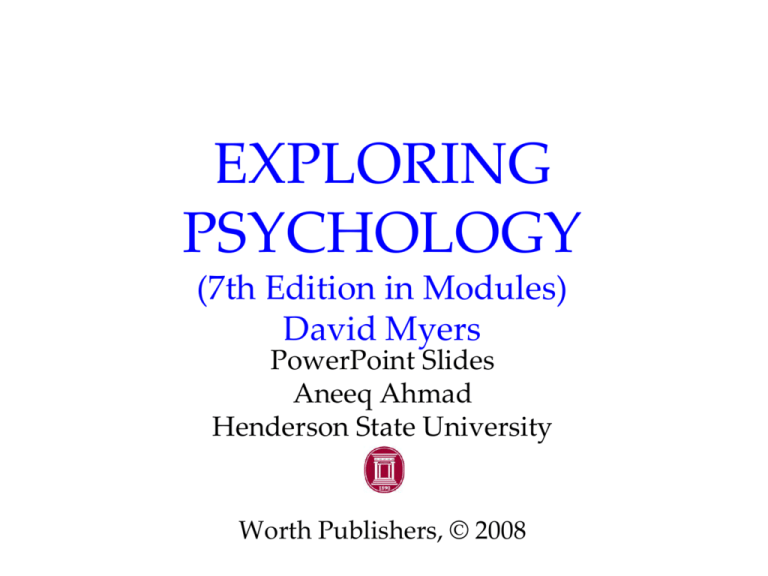
EXPLORING PSYCHOLOGY (7th Edition in Modules) David Myers PowerPoint Slides Aneeq Ahmad Henderson State University Worth Publishers, © 2008 Infancy and Childhood Module 8 Infancy and Childhood Infancy and Childhood Physical Development Cognitive Development Social Development Infancy and Childhood Infancy and childhood span from birth to the teenage years. During these years, the individual grows physically, cognitively, and socially. Stage Span Infancy Newborn to toddler Childhood Toddler to teenager Physical Development Infants’ psychological development depends on their biological development. To understand the emergence of motor skills and memory, we must understand the developing brain. Developing Brain At birth, most brain cells are present. After birth, the neural networks multiply resulting in increased physical and mental abilities. Maturation The development of the brain unfolds based on genetic instructions, causing various bodily and mental functions to occur in sequence— standing before walking, babbling before talking—this is called maturation. Maturation sets the basic course of development, while experience adjusts it. Motor Development First, infants begin to roll over. Next, they sit unsupported, crawl, and finally walk. Experience has little effect on this sequence. Profimedia.CZ s.r.o./ Alamy Phototake Inc./ Alamy Images Jim Craigmyle/ Corbis Renee Altier for Worth Publishers Maturation and Infant Memory The earliest age of conscious memory is around 3½ years (Bauer, 2002). A 5-year-old has a sense of self and an increased long-term memory, thus organization of memory is different from 3-4 years. Courtesy of Carolyn Rovee-Collier Amy Pedersen Cognitive Development Piaget believed that the driving force behind intellectual development is our biological development amidst experiences with the environment. Our cognitive development is shaped by the errors we make. Both photos: Courtesy of Judy DeLoache Schemas Schemas are mental molds into which we pour our experiences. Assimilation and Accommodation Bill Anderson/ Photo Researchers, Inc. The process of assimilation involves incorporating new experiences into our current understanding (schema). The process of adjusting a schema and modifying it is called accommodation. Jean Piaget with a subject Piaget’s Theory and Current Thinking S e n s o rim o to r S ta g e In the sensorimotor stage, babies take in the world by looking, hearing, touching, mouthing, and grasping. Children younger than 6 months of age do not grasp object permanence, i.e., objects that are out of sight are also out of mind. Doug Goodman Sensorimotor Stage: Criticisms Piaget believed children in the sensorimotor stage could not think —they do not have any abstract concepts or ideas. However, recent research shows that children in the sensorimotor stage can think and count. 1. Children understand the basic laws of physics. They are amazed at how a ball can stop in midair or disappear. Sensorimotor Stage: Criticisms 2. Children can also count. Wynn (1992, 2000) showed that children stared longer at the wrong number of objects than the right ones. Preoperational Stage Piaget suggested that from 2 years old to about 6-7 years old, children are in the preoperational stage—too young to perform mental operations. Ontario Science Center Preoperational Stage: Criticism DeLoache (1987) showed that children as young as 3 years of age are able to use metal operations. When shown a model of a dog’s hiding place behind the couch, a 2½-year-old could not locate the stuffed dog in an actual room, but the 3-year-old did. Egocentrism Piaget concluded that preschool children are egocentric. They cannot perceive things from another’s point of view. When asked to show her picture to mommy, 2year-old Gabriella holds the picture facing her own eyes, believing that her mother can see it through her eyes. Theory of Mind Preschoolers, although still egocentric, develop the ability to understand another’s mental state when they begin forming a theory of mind. The problem on the right probes such ability in children. Concrete Operational Stage In concrete operational stage, given concrete materials, 6- to 7-year-olds grasp conservation problems and mentally pour liquids back and forth into glasses of different shapes conserving their quantities. Children in this stage are also able to transform mathematical functions. So, if 4 + 8 = 12, then a transformation, 12 – 4 = 8, is also easily doable. Formal Operational Stage Around age 12, our reasoning ability expands from concrete thinking to abstract thinking. We can now use symbols and imagined realities to systematically reason. Piaget called this formal operational thinking. Formal Operational Stage Rudiments of such thinking begin earlier (age 7) than what Piaget suggested, since 7-year-olds can solve the problem below (Suppes, 1982). If John is in school, Mary is in school. John is in school. What can you say about Mary? Reflecting on Piaget’s Theory Piaget’s stage theory has been influential globally, validating a number of ideas regarding growth and development in many cultures and societies. However, today’s researchers believe the following: 1. Development is a continuous process. 2. Children express their mental abilities and operations at an earlier age. 3. Formal logic is a smaller part of cognition. Social Development Stranger anxiety is the fear of strangers that develops at around 8 months. This is the age at which infants form schemas for familiar faces and cannot assimilate a new face. © Christina Kennedy/ PhotoEdit Origins of Attachment Harlow Primate Laboratory, University of Wisconsin Harlow (1971) showed that infants bond with surrogate mothers because of bodily contact and not because of nourishment. Origins of Attachment Like bodily contact, familiarity is another factor that causes attachment. In some animals (goslings), imprinting is the cause of attachment. Alastair Miller Attachment Differences Placed in a strange situation, 60% of children express secure attachment, i.e., they explore their environment happily in the presence of their mothers. When their mother leave, they show distress. The other 30% show insecure attachment. These children cling to their mothers or caregivers and are less likely to explore the environment. Secure Attachment Relaxed and attentive caregiving becomes the backbone of secure attachment. Berry Hewlett Insecure Attachment Harlow’s studies showed that monkeys experience great anxiety if their terry-cloth mother is removed. Harlow Primate Laboratory, University of Wisconsin http://www.youtube.com/watch?v=KlfOecrr 6kI Attachment Differences: Why? Why do these attachment differences exist? Factor Explanation Mother Both rat pups and human infants develop secure attachments if the mother is relaxed and attentive. Father In many cultures where fathers share the responsibility of raising children, similar secure attachments develop. Separation Anxiety Separation anxiety peaks at 13 months of age, regardless of whether the children are home or sent to day care. MARY AINSWORTH • STRANGE SITUATION EXPERIMENTS. • Studied attachment differences by observing mother-infant pairs at their homes in their first 6 mths. • Later she observed them in a strange situation without their mothers (1 year old) • Video Clip Deprivation of Attachment What happens when circumstances prevent a child from forming attachments? In such circumstances children become: 1. Withdrawn 2. Frightened 3. Unable to develop speech Prolonged Deprivation If parental or caregiving support is deprived for an extended period of time, children are at risk for physical, psychological, and social problems, including alterations in brain serotonin levels. Child-Rearing Practices Practice Description Authoritarian Parents impose rules and expect obedience. Permissive Parents submit to children’s demands. Authoritative Parents are demanding but responsive to their children. Uninvolved/Ne glectful Parent is emotionally detached, withdrawn, and inattentive Authoritative Parenting Authoritative parenting correlates with social competence — other factors like common genes may lead to an easy-going temperament and may invoke an authoritative parenting style. WORD OF CAUTION • The association between certain parenting styles and certain childhood outcomes is » CORRELATIONAL » IT IS NOT A CAUSATION!! TWO other possible explanations for this parenting-competence link: 1. Children’s traits may influence parenting more than vice versa. 2. Some underlying third factor may be at work-Perhaps, for example, competent parents and competent children share genes for social competence.
